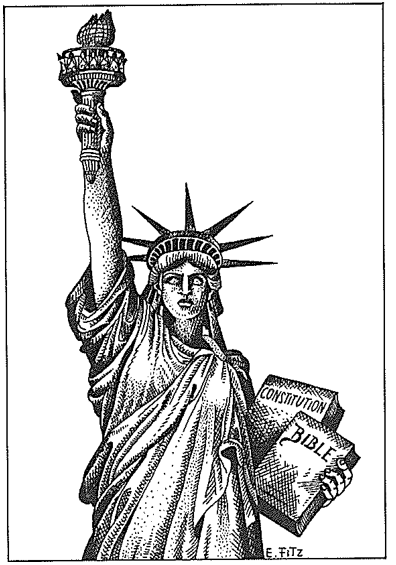In writing The Naked Public Square, Richard John Neuhaus, a Lutheran pastor, was undoubtedly conscious of Lutheranism’s potentially central role in mediating the religious-moral battles now so conspicuous on the American scene. Liturgical and dogmatic, yet firmly evangelical, mainstream in some of its American manifestations and quasi-sectarian in others, running the gamut from the most sophisticated theology to simple pietism, Lutheranism perhaps holds within itself the possibility of refereeing the conflicting claims of Catholics and Evangelicals, liberals and fundamentalists.
Although Neuhaus suggests Lutheranism’s possible role briefly and tentatively towards the end of the book, there is a sense that he also realizes that it is unlikely. His church’s modest numbers may themselves deny it such a role, along with its concentration in a relatively few geographical areas. Its tradition is not one of vigorous action in the public realm, nor of far-reaching thought about the relationship of religion and the state.
Before alluding to the potential of his own denomination, Neuhaus discusses the “Catholic moment” which he says by rights should now have come in America. For, although Catholicism suffers from the obvious disabilities of the Reformation legacy, especially the lingering sense that it is an alien faith in a Protestant land, it does possess the numbers, the traditions, and the political and intellectual sophistication which might enable it to oversee the filling up of the square.
Here the author is too optimistic. He rightly points out that the election of John F. Kennedy was not the Catholic moment it has often been thought, because, as Neuhaus pithily puts it, Kennedy “reassured the electorate that he was not a very serious Catholic.” If anything, his election delayed the Catholic moment by a generation, and possibly forestalled it permanently.
Neuhaus goes on to say that he disagrees with those who say that the Catholic Church began to unravel at the moment its spiritual son was elected to the nation’s highest office. Catholicism’s “silly season” is now behind it, Neuhaus insists. But that is a misapprehension. There is perhaps less overt “silliness” now than there was 10 years ago (e.g., not as much is heard about Mass being celebrated amidst balloons and dancing girls, with pizza and Coke for the eucharistic elements). However, that is because in so many ways the trendiest notions of the counterculture and the New Left are now simply taken for granted, even if in some what less flamboyant form.
The working philosophy of the most articulate and influential nuns, for example, is simply the most extreme kind of feminism. If particular religious orders, male and female, can be said to have an official creed, its tenets would have to include unblinking support for every self-proclaimed revolutionary movement in the “third world” and the working assumption that capitalism and the United States are the source of most of the evil in the world. Mainstream Catholic theology to a large extent defines itself by what it rejects in the Catholic tradition. In the midst of all this the majority of the American bishops concede to the radicals as much as they possibly can without formally transgressing official doctrine.
Although Neuhaus is aware of the internal problems of the various churches, more attention might have been given to the way in which the square has been denuded in large part because those who traditionally kept it full, especially the churches, acquiesced as its furniture was carted away as debris. Or, correlatively, those whose traditional task was to keep the square filled simply lost their sense of authority. American Catholicism arrived at this point later than did the mainstream Protestants, but its malaise is probably almost as deep, relieved only by a strong pope who does have the power, ultimately, to effect a transformation in the leader ship of that church.
If the square is empty in part because Americans do not know what to fill it with, it is also true that an empty square tends to suck the contents out of the communities, including churches, which border it. Mainstream religious leaders now keep glancing nervously into the square to judge what is or is not appropriate for them to do or say. The naked square functions as a religious Gresham’s Law, the ultimate in spiritual lowest common denominators.
Although the book will probably be denounced by some liberals as aiming to violate strict separation of church and·state, it is in fact a work of what can be called “the extreme middle.” Neuhaus moderately and intelligently raises the necessary, if neglected, questions about the relation of belief and the public order and calmly reveals the sophistries and unexamined assumptions by which a dogmatic secularism has often been imposed. At the same time, he is clearly uneasy with the “religious new right”–the Moral Majority, etc.–whom he credits with having legitimate concerns but whose dogmatism and lack of sophistication he regards as dangerous to the public order.
The problem, as Neuhaus recognizes elsewhere in the book, is that genuine religion is by nature a volatile substance, not easily captured in the categories of “civility” and compromise. As both religious and secular history have shown abundantly, moral revivals, whether overtly religious or chiefly secular in character, quickly manifest themselves in “extreme” forms.
No great moral change in American life has occurred through reasoned discourse and careful and responsible negotiation of competing claims. Every such event has involved bruising conflict and intense polarization. No where is this better illustrated than in the successful secular movements of the past quarter century-civil rights, the antiwar movement, feminism, environmentalism, etc.
Pastor Neuhaus has presented a carefully thought-out analysis with which no fair-minded person could seriously quarrel. It seems unlikely, however, that he has provided the prescription by which the problem will finally be resolved.

Leave a Reply